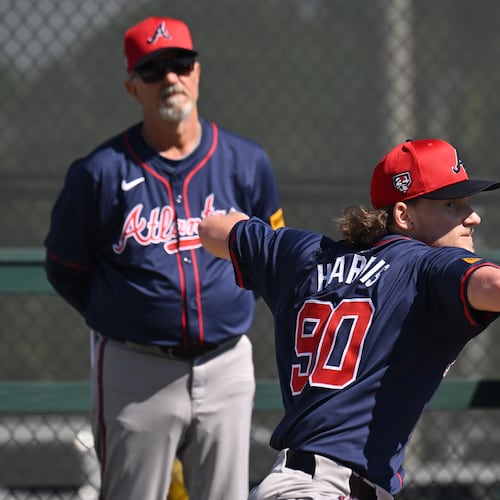If the Braves have become the Green Bay Packers of baseball, then Touki Toussaint could be Aaron Rodgers. Pardon the mixed sports analogies and hear me out.
General manager Ted Thompson’s strategy to build the Packers into a strong organization was to stockpile as many draft picks as possible. With a league-high 104 picks since 2009, Thompson hasn’t had to hit on an unreasonable percentage of prospects to build a winner and also had the luxury of drafting Rodgers when he had Brett Favre.
Braves boss John Hart and general manager John Coppolella are doing the same. They’ve added about 25 prospects via trade since last winter. They also acquired two competitive-balance Round A draft picks and made three first-round picks in this year’s June amateur draft.
That brings us to Toussaint. The Braves acquired him in a trade with the Diamondbacks in June. He was at Turner Field recently for a camp of top Braves prospects, and even in a clubhouse full of potential big leaguers, Toussaint stood out.
He’s just 19 years old, but already looks the part at 6-foot-3, 185 pounds. Toussaint is a natural: He said he didn’t take pitching seriously until his junior year of high school, but by then he had already hit 97 mph with his fastball at a big tournament.
Writing at Baseball America, Bill Ballew cites “the electricity Toussaint’s arm generates” and his potential to have three quality pitches as reasons why he has “the raw ability that many aces tend to possess.” Toussaint just needs to throw more strikes.
It’s all projection and potential, words that mean Toussaint’s career (and the Braves’ plan) still could go either way. Lots of hotshots never make it to the majors. Patience is required.
“You are in this clubhouse and you feel like a big leaguer,” Toussaint said. “It’s hard being patient because you wake up every morning and say, ‘I just want to get to the big leagues.’”
He has a good shot: Baseball America ranked Toussaint as the No. 71 overall prospect this year. No other Braves prospects made the list, but pitcher Kolby Allard and infielders Hector Olivera and Ozzie Albies could be included in next year’s top 100. Braves prospects Lucas Sims and Max Fried have appeared on previous top 100 lists.
The Braves have more raw talent in their system now, but how many of those young players will become good or even average big leaguers? Most won’t.
Blogger Matt Perez analyzed the major league success rate of Baseball America’s top 100 prospects from 1990-2006. Perez, who expanded on earlier work by Victor Wang and Scott McKinney, used Wins Above Replacement to measure “success” and grouped prospects in broad categories as “bust” or “success.”
Perez’s conclusion: “Three out of every four pitching prospects fail, and two out of every three hitting prospects fail. About 70 percent of all prospects fail.” Baseball is a hard game, and so it follows that it’s difficult to project which raw prospects can succeed at the top level.
But, again, the Braves have more leeway to be wrong about their prospects because they have more of them now. If they have five top-100 prospects and two eventually become good major leaguers, that’s success. There also are players who never make the top 100 who go on to be very good big leaguers: A later study by Perez concluded that Baseball America lately has “predicted fewer superior prospects than they once did.”
It’s not unreasonable to believe that, say, four of the prospects accumulated by the Braves eventually will become good major leaguers. That’s a solid, fiscally cheap foundation upon which to add proven players.
If one or two top Braves prospects become stars, especially at a key position like Toussaint’s, then it’s a home run. They are not easy to find, but the Packers hit on Rodgers so why not the Braves? They have the numbers.
About the Author
Keep Reading
The Latest
Featured


